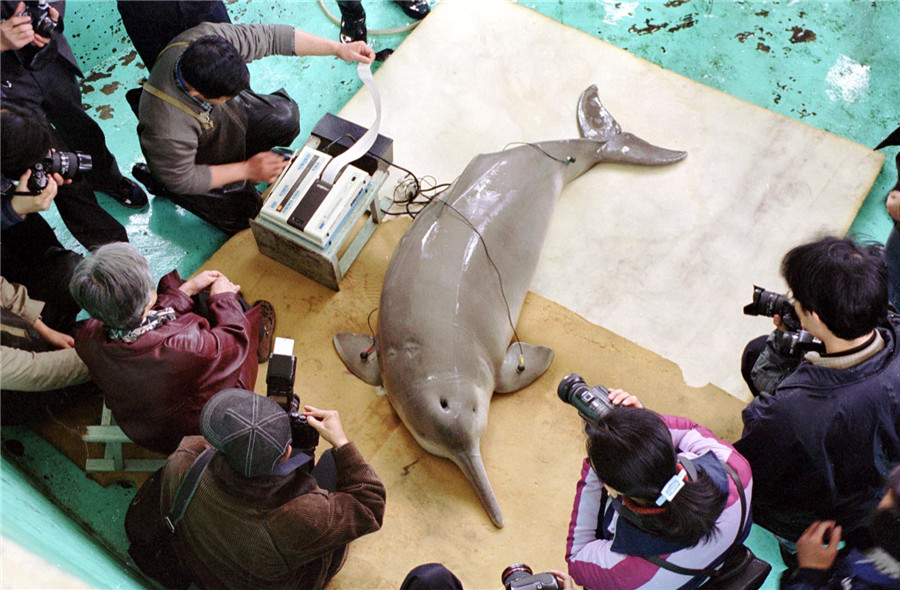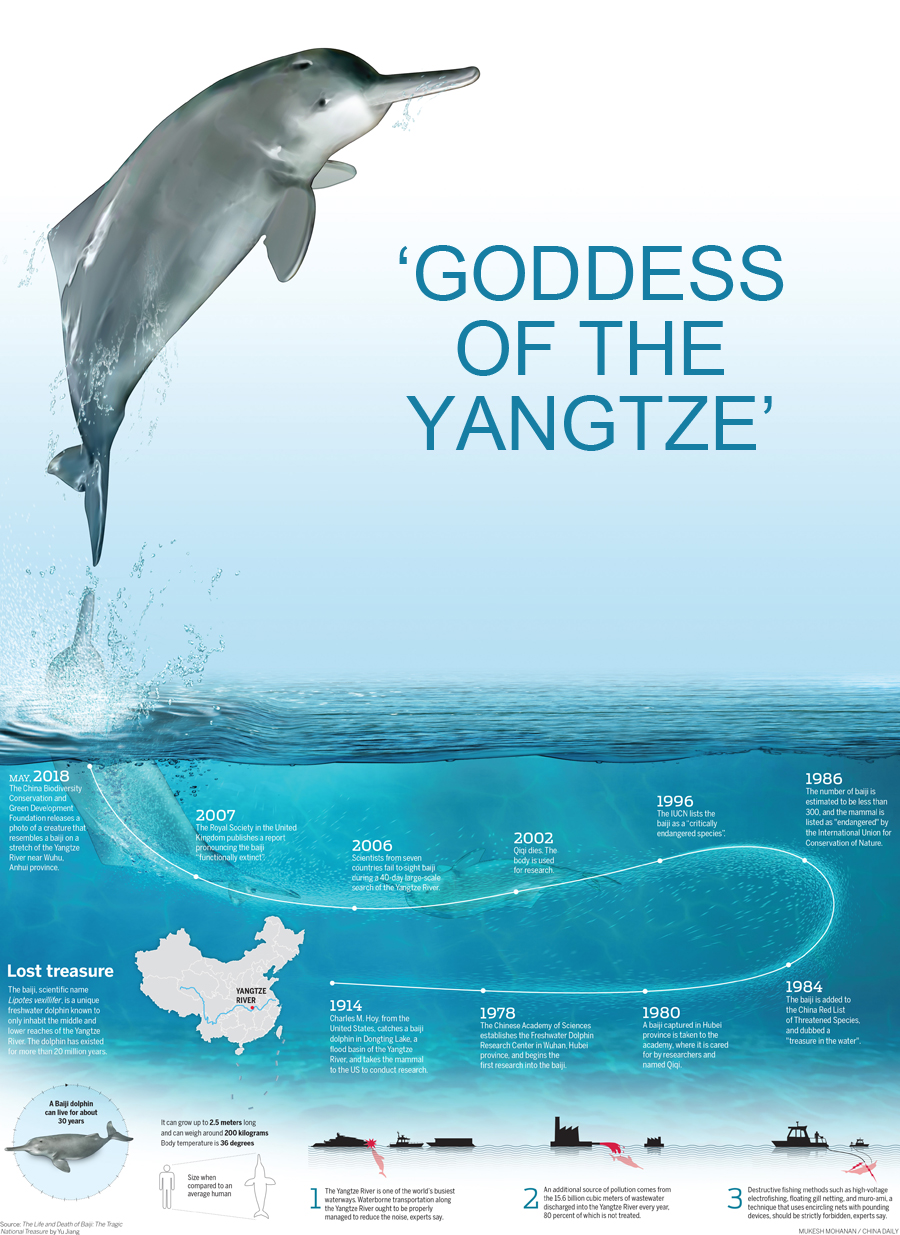By Luan Xiang | China Daily
The baiji is believed to be extinct, but some observers claim to have sighted the freshwater mammal as recently as last month, as Luan Xiang reports for Xinhua China Features.
More than a decade has passed since the baiji was declared "functionally extinct."
Yet a recent image believed to show the long-missing "Goddess of the Yangtze River" has sparked hopes for the mammal's reappearance as Asia's longest waterway recovers its ecological vitality.
Many observers believe the dolphin, a unique freshwater species only found in the middle and lower stretches of the Yangtze, is now extinct in the wild.
However, some environmental scientists have never stopped believing that somewhere within the vast drainage area of the world's third-longest river a few remaining members of the rare species may be fighting for survival, far from human activity.
Earlier this month, the China Biodiversity Conservation and Green Development Foundation released a photograph of a creature resembling a baiji taken in April on a stretch of the Yangtze near Wuhu in the eastern province of Anhui.
Previously, two reports had circulated of fishermen spotting a small pod of the blueish-gray mammals that contained both adults and calves.
Rising optimism
The foundation claimed that several researchers who have worked closely with the baiji or specialize in studying it have confirmed that the creature shown in the image was a surviving specimen.
"Though the baiji is very likely to have become extinct in the wild, the possibility remains that a few last surviving specimens could still be out there," said Wang Kexiong, a professor at the Institute of Hydrobiology of the Chinese Academy of Sciences in Wuhan, Hubei province.
The institute said it would be imprudent to identify the creature in the photograph without further evidence. Nevertheless, some observers said it is too soon to label the species "extinct".
The proof goes beyond just one image, according to Su Fei, director of the Baiji Program at the foundation. For three years, the organization has been organizing observation trips in the hope of sighting the Yangtze's unique freshwater dolphin.
In May last year, several observers claimed to have witnessed the elegant mammal.
The baiji does not live in isolation, according to Li Xinyuan, an investigator and baiji enthusiast who was present when the photo was taken last month and described the encounter as "extremely emotional".
"For two days straight, our teammates witnessed the baiji, but it was gone before they could press the (camera) shutter. On the third day, the photographer Jiao Shaowen decided to use a camera lens rather than binoculars to observe the surface of the water, so he was able to take the shot the instant the baiji emerged," said Li, who led an ex-situ, or "off-site", conservation project on the mammal in the 1980s.
He believes that if a baiji was actually spotted, it's likely that a small pod was swimming nearby.
"It is noticeable that the river's water quality and ecosystem have improved in recent years, thanks to State-led protection efforts," he said.
He added that many observers are optimistic about a reappearance of the baiji if the environmental improvement continues.
Resources required
Hua Yuanyu, one of the first scientists to survey the species back in the 1980s, said, "To salvage the possible surviving baiji dolphins, emergency action needs to be taken using the country's best resources, talent and technology.
"Waterborne transportation along the Yangtze ought to be properly managed to reduce the noise that has gravely affected the lives of these sonar-guided dolphins," said the retired professor from the Life Science Institute at Nanjing Normal University in Jiangsu province.
He condemned destructive fishing methods such as high-voltage electro-fishing, floating gill netting, and muro-ami, a technique in which encircling nets are fitted with "pounding devices" such as large rocks or concrete blocks that are designed to scare fish from hiding places.
These practices should be strictly forbidden, and any violation should be punished to protect both the dolphins and their prey, Hua said.
"The baiji is a mammal that uses lungs to breathe. If shocked by electricity, it may lose consciousness and drown," he said, criticizing the fishing practices as well as the discharge of waste into the waterway.
He called for improved law enforcement and for local fishermen to be better educated to help them become protectors of the ecosystem.
"Protection of the Yangtze should include the water, the banks and the wetland along its path, because the ecosystem is one whole," he said,
He suggested that the protection zone for river dolphins should be extended to cover the habitat of the possible last few baiji in Wuhu.
"I am optimistic that if the environment continues to improve, the baiji will come back," said Hua, who invented a sonar orientation method that he and his team used to observe and deduce the size and distribution of the baiji population in 1986.
In the mid-1980s, there were still about 300 baiji living in 42 family-like pods along the river. Hua believes that these intelligent mammals have been hiding from human activity and river industries, quietly surviving in unexploited, serene waters.
Eco-restoration
The baiji flourished in the middle and lower reaches of the Yangtze for more than 20 million years.
However, in recent decades that peaceful existence was shattered by the rise of industrialized fishing and a transportation boom that pushed the species to the edge of extinction.
In ancient times, the mammal was regarded as a goddess that protected fishermen and sailors along the 6,380-kilometer-long waterway that rises in Qinghai province in Northwest China and enters the East China Sea at Shanghai.
Once described as "numerous," the last known captive baiji died in 2002. After an international expedition in late 2006 failed to find any proof of its continued existence, the species was declared "functionally extinct" the following year.
On the International Union for Conservation of Nature's Red List of Threatened Species, the baiji dolphin is designated as "critically endangered, possibly extinct".
In the absence of the "goddess," China has been making vigorous efforts to restore the ecosystem of the Yangtze.
The construction of an ecological civilization has even been written into the Constitution as a national development objective.
As a result, scientific surveys have confirmed a rise in numbers of the Yangtze finless porpoise, another of the river's mammalian residents.
The supposed reappearance of the baiji is more evidence of the ecological improvement of the Yangtze, according to Hua.
Wang, from the hydrobiology institute in Wuhan, said there is still a long way to go in the protection and restoration of the river's natural habitats for species such as the finless porpoise.
"But the current development strategy has been adjusted in the right direction," he said.
"Monitoring, protecting, revitalizing and restoring the ecology and natural habitats of the Yangtze River should be our main tasks for the next 50 years."
![File photo of baiji [Photo IC].jpeg File photo of baiji [Photo IC].jpeg](http://file.cbcgdf.org/T18/O125/image/20180530/20180530223219_3378.jpeg)
File photo of baiji [Photo/IC]

Expert does ECG check for a baiji [File photo/IC]

photo: China Daily
original link: http://www.chinadaily.com.cn/a/201805/29/WS5b0c9d25a31001b82571cca4_3.html
